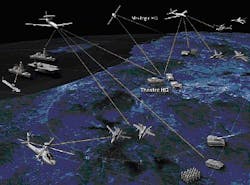Company to develop enabling technologies for 100-gigabit-per-second wireless data link
ARLINGTON, Va., 19 July 2013. Wireless data communications experts at Applied Communication Sciences in Basking Ridge, N.J., are developing a military wireless data link able to transmit data at 100 gigabits per second within one radio frequency channel under terms of a $4.3 million contract announced this week by the U.S. Defense Advanced Research Projects Agency (DARPA) in Arlington, Va.
Applied Communication Sciences experts are doing the work for the DARPA 100 Gb/s RF Backbone (100G) program, which will create an airborne communications link with fiber-optic-equivalent capacity and long reach that can propagate through clouds, rain, and fog, and provide high availability.
Applied Communication Sciences will develop approaches for blending high-order modulation with spatial multiplexing to achieve spectral efficiencies greater than 20 bits-per-second-per hertz, and provide 100-gigabit-per-second capacity at ranges of 125 miles for air-to-air links and 62 miles for air-to-ground links from an aircraft flying at about 60,000 feet.
The program's 100-gigabit-per-second airborne data links are to connect the major nodes of military networks, and to handle voice, video, Internet, and enterprise data flows.
Although the U.S. civil telecommunication infrastructure relies heavily on single-mode optical fiber as the data backbone, military communications cannot rely on a fixed infrastructure for deployed operations, DARPA experts explain. Instead, the military needs to project fiber-optic-equivalent capacity anywhere within its area of responsibility with a relative lack of communications infrastructure.
In the first phase of the DARPA 100G program, Applied Communication Sciences experts will focus on developing technology for a 100-gigabit-per-second data communications prototype.
Later, the program will develop prototype 100G transceivers and integrate them into aircraft and fixed ground sites, and then build a final prototype for flight testing.
DARPA officials say they expect to award several contracts for the first phase of the 100G program, so the deal with Applied Communication Sciences may only be the first on the project.
About $18.3 million will be split among contractors for this phase, which will concentrate on high-order modulation at millimeter-wave frequencies, and developing ways to generate, transmit, receive, and process high-order modulation at millimeter-wave frequencies. Applied Communication Sciences will build a transmitter and receiver.
Other portions of the program involve spatial multiplexing at millimeter-wave frequencies to reduce transmit power, and proof-of-concept demonstrations for operating the 100G system.
For more information contact Applied Communication Sciences online at www.appcomsci.com, or DARPA at www.darpa.mil.

